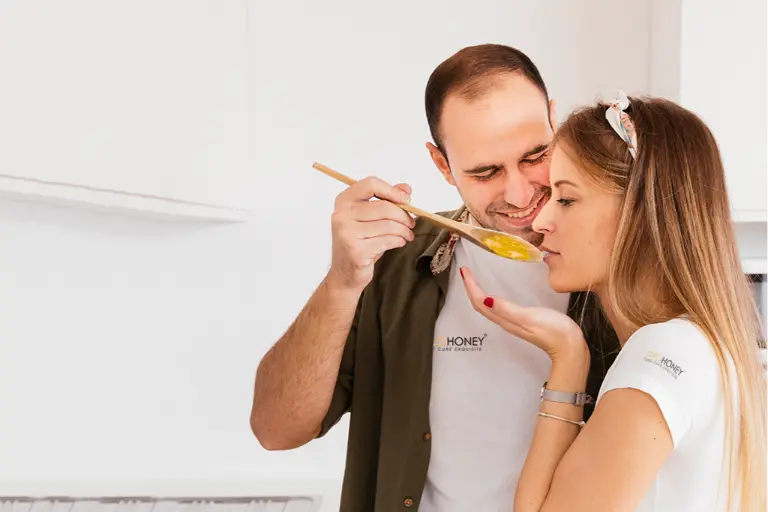- Tokyo: 14:01
- Singapore: 13:01
- Dubai: 09:01
- London: 05:01
- New York: 00:01
What Is Manuka Honey and Why It’s Unique

In the world of natural sweeteners, remedies, and superfoods, nothing can beat the exotic Manuka Honey. This flavor-rich and nutrient-dense substance is the top priority for honey lovers all over the globe. This special honey variety is exclusive to New Zealand, where the natives have been using it as a potent healing agent and culinary ingredient for ages. Apart from possessing a complex and rich flavor, this honey also has exceptional antibacterial properties. “Manuka honey is a powerhouse of nutrients, and its regular use can make you both look and feel energetic all day, every day.”, says the founder of Geohoney and the CEO of B A Barry Group, Mr Basem Barry. But what is it exactly that makes this pure raw honey so special? This is what this blog is all about. So, if you wish to know why Manuka honey stands out from the rest, then keep on reading till the end. A Look into the World of Manuka Honey: What Makes it So Special? How to Determine the Authenticity of Manuka Honey? Benefits of Manuka Honey for Your Health Manuka Honey VS Regular Honey: Key Differences Why is Manuka Honey So Expensive? What Makes Manuka Honey Rare? Manuka is among the rarest types of honey that possess a unique origin, physical features, and nutritional profile. This honey is different in the way it is prepared, harvested, and processed, and that is exactly what makes it better than most regular honey varieties. Let’s dive a little deeper into the exciting world of Manuka honey to show you what makes it so special and unique. Manuka honey originates exclusively from New Zealand, which is home to the Manuka bush (Leptospermum scoparium). The manuka grows in the remote, uncultivated but pristine parts of this region. The premium grade Manuka honey hails from the Taranaki on the West Coast, the wild East Cape, and the North Island in Northland, which is the area the local beekeepers call The Golden Triangle. This honey is harvested using a traditional, labor-intensive process, which ensures maximum purity. This exotic honey variety is not widely available, and the reason is the very limited and short flowering span of the Manuka plant blossoms. This plant only blooms for 2 to 6 weeks between late spring and early summer, giving bees little time to collect the nectar and prepare honey. Here is how this honey is harvested. First, local beekeepers determine the flowering seasons of the Manuka plant and then move their hives to areas where these are in high concentration. The bees then collect the nectar and make honey naturally. Once the honey is made, beekeepers carefully remove hives, take them to dedicated honey extraction facilities, and extract the honey using centrifuges. The honey is then strained and filtered to remove impurities. Then, the honey is tested and graded to label its potency and purity. Finally, it is packaged and delivered to the consumers and businesses globally. Apart from unique origins and harvesting practices, this honey also possesses some distinct physical features. Here is how you can identify this unique honey. Flavor Profile Unlike regular honey, which is extra sweet, Manuka honey possesses a rich, earthy, and slightly bitter taste. Its flavor resembles caramel with bitter herbal undertones. This honey is less sugary and more tangy in flavor, which can be attributed to its high MGO content. Aroma This honey has a bold, earthy aroma that has herbal, slightly smoky, and medicinal undertones. Higher-grade Manuka honey gives a slightly musty or nutty aroma, which is the result of the presence of VOCs in its composition. Color The color of this honey depends on its MGO level or UMF grade. Generally, this honey comes in dark creamy to dark brown hues. Some higher-grade Manuka honey varieties can be even darker in color. Texture Manuka honey has a thick and creamy texture. You can also describe its consistency to be smooth, velvety, dense, but spreadable. The low moisture and high sugar content of this honey lead to its slower crystallization and longer shelf life. Manuka honey contains several unique bioactive compounds that you do not normally find in other organic honey varieties. It contains the following key components that give it potent medicinal effects. It has MGO, which makes it an effective antibacterial agent. It has Dihydroxyacetone (DHA), which is the precursor to MGO in this honey. It is rich in Leptosperin, which is a potent phytochemical that gives anti-inflammatory and antioxidant properties to Manuka honey. It also contains phenolic compounds and flavonoids that give it immune-boosting and antioxidant features. Apart from these specific bioactive compounds, Manuka honey also contains 15-17% water, proteins, calories, carbs, and trace amounts of vitamins (B1, B2, B6, Niacin). And not just that, this honey also gives you minerals like sodium, potassium, iron, zinc, calcium, magnesium, and phosphorus. This impressive nutritional profile is what sets this honey apart from the rest. The worldwide popularity of Manuka honey has led to many cheap imitations or adulterated products circulating in the market. This makes it very hard for you to make sure the honey you just bought is authentic and pure. However, there are some tests that help you determine the quality of your Manuka honey. Before buying this honey, make sure it has been tested and graded using the following methods. The most effective way to determine the authenticity of your Manuka honey is by looking at its UMF rating. UMF, which stands for unique Manuka factor, is a grading or certification system that is used in New Zealand to determine the MGO, DHA, and Leptosperin contents of the Manuka honey. This system gives you an idea about the purity, origin, and authenticity of Manuka honey. Manuka honey with UMF 5 to 9 is suitable as a sweetener. UMF 10 to 15 Manuka has mild medicinal properties due to low MGO contents. UMF 15+ Manuka honey has the highest MGO content and the highest potency, which is why it is most commonly used for medicinal purposes. This test is used to determine the Methylglyoxal (MGO) content of Manuka honey, which gives it its potent antibacterial properties. Authentic and high-grade Manuka honey has an MGO of 100 mg/kg to 400+ mg/kg. The more the MGO content, the more potent the Manuka honey. This test tells you about the leptosperin content in Manuka honey, which gives an estimation of its botanical authenticity and antioxidant features. Leptosperin is only found in the nectar of Manuka flowers, which means it cannot be faked or added afterward, which makes this test a great way to ensure the originality of Manuka honey. This is another effective test that allows you to determine the floral origin of Manuka honey and to predict its MGO levels. The New Zealand Ministry of Primary Industries (MPI) used strict standards to maintain the authenticity of the Manuka honey. Make sure the Manuka honey you buy is certified and graded by the MPI to ensure its authenticity and traceability. The following are some major health benefits of Manuka honey that show why you need to add it to your daily diet and lifestyle. A Natural Source of Energy This honey is rich in natural sugars, MGO, antioxidants, vitamins, and minerals. It also contains calories, proteins, and beneficial enzymes that ensure you stay healthy, energetic, and fueled throughout the day. Enhances Digestive Health This honey contains prebiotic oligosaccharides that keep your gut healthy. Its antibacterial features ensure your gastrointestinal system stays in the best shape. Manuka honey soothes inflammation and promotes the growth of healthy bacteria in your gut. This prevents IBS, diarrhoea, bloating, and other digestive issues. Enhances Immunity High MGO levels and greater antioxidant concentrations of Manuka honey prevent oxidative stress on your body and stimulate immune cell activity, which strengthens your immune system. Contains Antioxidants Pure Manuka honey is a rich source of antioxidants like phenolic acids and flavonoids, which neutralize environmental stressors, keeping you healthy both inside and out. Relieves Sore Throat Manuka honey fights destructive microbes called Streptococcus, which are linked to sore throats. Regular use of this honey can treat and prevent sore throat and common cold symptoms. Its cough suppressant and immune-boosting properties further make it an effective remedy for seasonal allergies. Treats Acne This honey has both anti-inflammatory and antimicrobial effects, which makes it a perfect ingredient for face masks, lotions, and creams. Regular use of this honey destroys acne-causing bacteria and maintains the pH levels of your skin. This gives you clear and radiant skin without any side effects. Heals Minor Burns and Wounds You can apply Manuka honey topically to minor wounds, burns, or abrasions. It creates a protective layer over the damaged parts of your skin, which stops infections and promotes faster and healthier regeneration of cells and tissues. Enhances Oral Health Manuka honey prevents gum inflammation, tooth decay, plaque formation, and other major oral issues. It does that by eliminating Porphyromonas gingivalis and Aggregatibacter actinomycetemcomitans bacteria from your mouth. Manuka honey is far superior to regular honey when it comes to its flavor, nutritional profile, and therapeutic effects. The following are some key differences between regular honey and Manuka honey that clearly show why it is the best. Manuka honey is among the most expensive monofloral honey varieties out there, and the following are a few reasons why. Geographical Limitations Unlike regular honey, which is made by wildflowers or plants that are found in most parts of the world, Manuka honey is only made in New Zealand and from the nectar of Leptospermum scoparium (Manuka bush), which only grows in remote regions of this country. This geography limits the supply of Manuka honey, which drives up the price. Short Flowering Season The Manuka tree blossoms for only about 2 to 6 weeks, which greatly limits the nectar collection and the honey production, which is another reason why this rare honey is so expensive. High Demand in the Health and Wellness Sector This honey has high MGO content and potent medicinal properties, which are not found in regular honey. This increases the demand for this honey in the health and wellness sector, where people use it to create homemade remedies, commercial skincare products, and healthy foods and beverages. Strict Testing Each batch of Manuka honey is vigorously tested to make sure it meets the local and international quality and purity standards. The testing and grading of this honey is a costly endeavor, which also contributes to its high prices. Low Yield Manuka flowers bloom for a short time, and they also produce very little nectar. This leads to low honey yields and high prices. Labor Intensive Harvesting Conditions Manuka bushes grow in remote and hard-to-reach areas. To access these locations and extract honey, beekeepers use special means of transport and harvesting tools. Other factors, like wind or rain can also make the harvesting more time-consuming and physically draining. This also contributes to the high prices of Manuka honey. The following are a few points that show why this honey is so rare. This honey is made exclusively from manuka plants that are native to some parts of New Zealand. This is the only monofloral honey that has a high MGO content and which leads to its unparalleled antibacterial properties. This honey has its own dedicated grading system known as UMF, which indicates its purity and authenticity. The production of this honey is limited by the short blossoming time of the Manuka bushes and the labor-intensive harvesting process. This honey undergoes extreme testing and certification processes, which also leads to limited availability. Manuka honey, New Zealand’s exotic golden elixir, is made from a seasonally limited source. The harvesting, testing, and packaging of this honey are done using intricate and environmentally friendly processes. This one-of-a-kind monofloral honey is a nutrient-rich, flavorful, and healthy natural sweetener that is sure to leave a lasting impression both on your palate and your body. This rare and expensive honey has no match when it comes to its flavor, color, and health benefits, and you must at least try it once to really understand what makes it so special and unique. Visit GEOHONEY today to buy the best pure monofloral honey sourced ethically from beekeepers from all over the globe to get the best value for your money.A Look into the World of Manuka Honey: What Makes it So Special?
Origins and Harvesting
Key Physical Features
Nutritional Profile
How to Determine the Authenticity of Manuka Honey?
The UMF Rating System: A Standard for The Quality and Potency of Manuka Honey
MGO Test
Leptosperin Content
DHA Test
MPI Grading
Benefits of Manuka Honey for Your Health
Manuka Honey VS Regular Honey: Key Differences
Why is Manuka Honey So Expensive?
What Makes Manuka Honey Rare?
Conclusion



